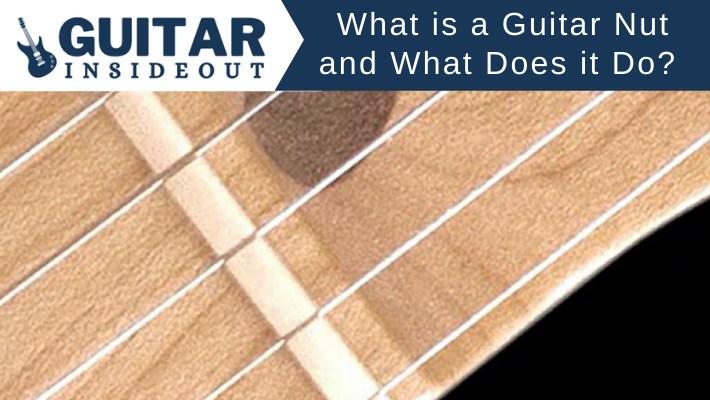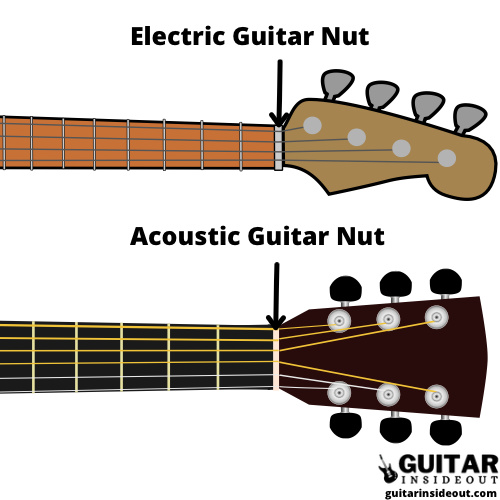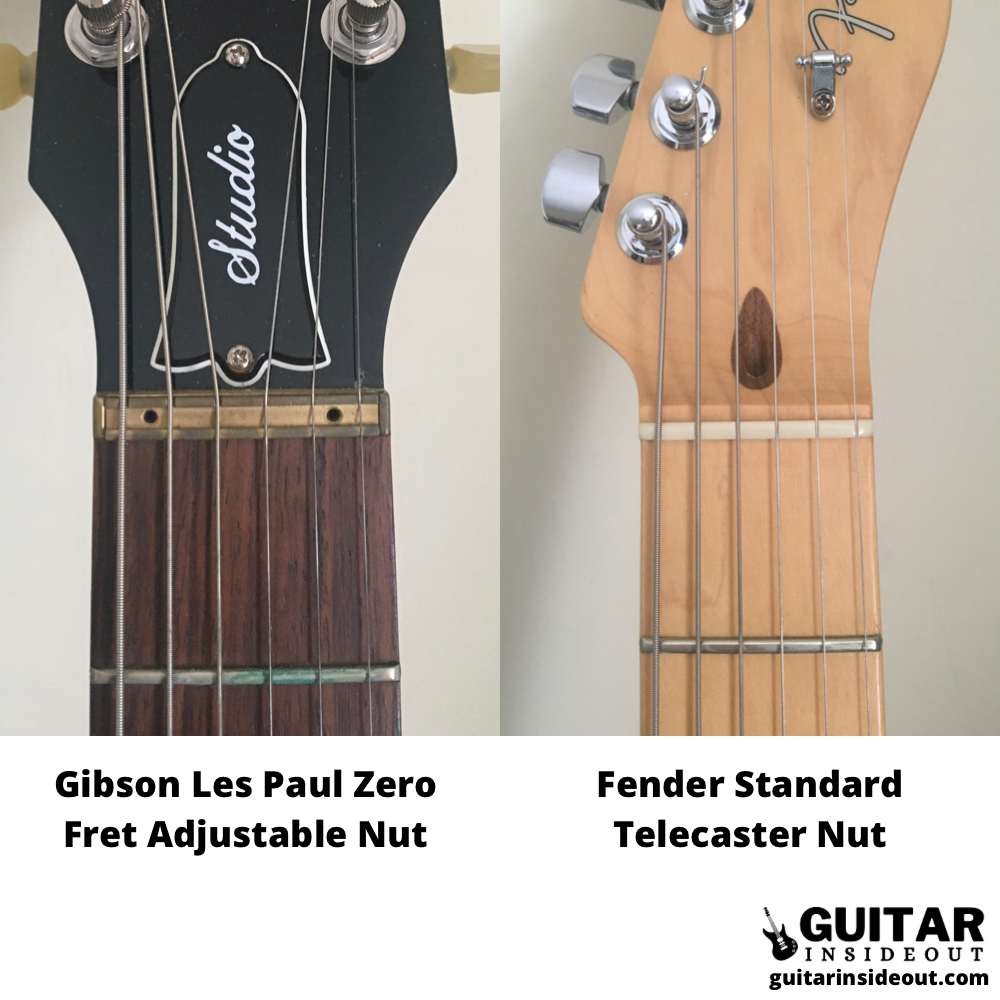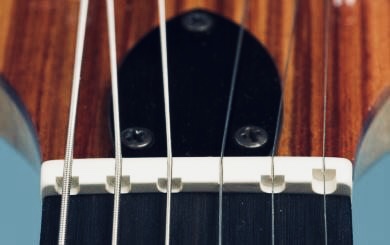Understanding the parts of the guitar can be confusing. Even if you’ve been playing for years you may still have gaps in your knowledge. I know as a casual player that I heard people talking about “the nut” and used to wonder “what is a guitar nut?” regularly.
There are so many new terms and odd language used in regards to the guitar it can be hard to get to grips with and understand it all. Sometimes it can feel like everyone is speaking a foreign language. Especially when you’re new to it all.

So if you’re trying to figure out what a guitar nut is and what it does this guide will explain in the simplest way everything about the guitar nut, where it is, what it does and more.
What is a Guitar Nut?
The guitar nut (also known as the ‘string nut’) is a very simple piece of material that the guitar strings sit in at the head of the guitar. It has grooves cut into it to hold the strings at the correct spacing across the fretboard and determine the length that they vibrate.
How deep these grooves are cut is key to how the guitar plays. If they are too deep then it will cause fret buzz and stop the strings from ringing out when they vibrate. Too shallow and the strings sit too high and make fretting more difficult.
The nut is essential to the guitar and can’t be played without one. It also affects the string action (the height the strings are from the fretboard), intonation and how it feels to play the guitar. It many look like an unassuming bit of material but it’s importance can’t be overstated.

Why is it Called The Nut?
Whilst there doesn’t seem to be any definitive answer as to why and how it came to be called ‘the nut’ it is thought it may have come from the German word for slot or groove – nut (pronounced “noot”).
Confusingly in German the term ‘nut’ is also referred to as the saddle. Whereas in English the saddle on a guitar is a part of the bridge. And violins also have a nut but it is called both the saddle or the nut.
So it seems the origin of the nut’s name is a bit of a mystery.
Where is the Nut on a Guitar?
The nut is found at the top of the neck just before the headstock of the guitar. If you follow your guitar strings from the bridge or body of the guitar all the way up the neck you will see a thin piece or block of material where the neck ends and becomes the head.
It will have grooves or slots that the strings are resting in. That’s the nut.
This picture should help you identify where your nut is:

What Does a Guitar Nut Do?
The nut has a few jobs. The grooves in the nut hold the strings at the correct action (height) from the fretboard. They also determine the spacing of the strings across the fretboard and the length which the strings vibrate – the strings end at the nut and so vibrate between that point and the bridge saddles.
On top of that the nut height and placement, along with the shape and depth of each slot have a dramatic effect on the guitar and how it sounds and plays. Without the nut being setup properly – that is shaping and sanding or filing it to fit perfectly – then you will find it impossible to get the best action on your guitar, the intonation will be off and the strings potentially misaligned.
Many guitarists also swear that the material of the nut can affect the tone you get when playing. Whilst this is hard to prove it shows how vital the nut it is and how much of an impact it can have across the guitar as a whole.
What are Guitar Nuts Made of?
Guitar nuts are usually made from bone or ivory, although brass, aluminium, plastic, graphite, steel, Tusq and more are also used. Each have different benefits but some are considered better than others.
Each material is different and has positives and negatives.
Bone
A bone nut is considered by many to be the best material for nuts. You’ll find bone nuts on Fender’s, Gibson’s and most of the best known guitar brands.
It provides excellent tuning stability and gives the guitar great sustain. As a natural material it makes them easier to cut and shape as well.
One of best advantages of using bone as a nut is the fact that it self lubricators. This means that it can withstand the biggest bends and still stay in tune.
The only real drawback to bone nuts is that being a natural material means you don’t get 100% consistency. Every bone nut is slightly different and that has a slight difference in the sound of each guitar.

Steel, Brass, Titanium etc.
Metal nuts were very popular in the 1980’s and come in many different types, like brass, titanium, steel and more. They have a very bright sound and because of their strength you can rely on them to last and not break.
The bright sound a metal nut creates is very distinctive and could be called an acquired taste. Few players use metal nuts nowadays though because of that sound.
You may still find heavy metal guitarists using a brass or steel nut as the clear tone it provides helps the heavy distortion used stay more defined. Also acoustic guitarists playing country or bluegrass are known to favor metal nuts.
Whilst they have benefits, most notably their durability, the impact on sound and tone is just too much for most people.

Plastic
Plastic nuts are one of the most common nut materials as they are cheap and easy to produce. If you buy a fairly cheap or lower priced guitar it’s likely it will have a plastic nut.
Plastic nuts don’t have to be bad but unfortunately often are. The cheaper the guitar the poorer the quality control and so you find badly cut and installed nuts on the lower end guitars.
Also if the plastic used to make the nut is soft it can affect the tuning stability and general playability of the guitar. But a decent, dense plastic that is installed properly and cut the right way will be fine. So it’s comes down to luck as to what you get.

Graphite
Graphite is one of the most popular types of guitar nuts. It’s less harsh and shrill sounding than metal but much more durable and reliable than plastic. Graphite is a happy middle ground that most guitarist will be pleased with.
Graphite also had the advantage of self lubricating to lower friction. This makes it extra popular with guitarists who use the tremolo a lot. Tuning stability is also very strong with graphite nuts and tremolo system.
The only drawback is the cheaper made graphite nuts can be dull sounding and really destroy the sustain of the guitar. Overall though they’re a great choice for a nut.

Tusq
Tusq is a type of high density plastic that was made to try and replicate bone nuts. It does a god job and is superior to regular plastic.
It also self lubricates like bone and provides similar sustain. Combine that with the fact that as it’s man made Tusq is completely even and lacking any of the irregularities a natural bone nut may have.
The differences between bone nuts and Tusq nuts is very minimal and many claim you cant actually tell the difference. Either way it’s such a small, barely noticeable change that it makes a lot of sense to switch or look for a Tusq nut in your next guitar (if you don’t already have one).

How Long Does a Guitar Nut Last?
The nut on a guitar should last for many years. Even the ones made from poorer quality material will last years before you need to replace it. You may even find that you never need to.
Over time the nut begins to wear from the constant pushing down of and bending of strings. It’s much more likely the nut will crack, break or chip before it wears down too much. However that should still take years to happen, even for the fairly weak plastic ones used in cheaper guitars.
If you’re worried about your nut wearing down or breaking, especially if it’s of a lower grade material, then it may be a good idea to replace it. You can switch to a bone or Tusq one that will last longer and may even improve your tone!
Thankfully if the nut does break/crack/chip or wear so much that it needs replacing they are nice and cheap to buy.
How Often Should you Change a Nut?
If you’re not having any issues with the nut, be that fret buzz, high action or damage, then you don’t need to change it. You should only really change the nut if it’s actually causing you problems or has broken.
For example if you find you’re getting fret buzz or the open strings aren’t ringing out. That can often be a problem with the nut and if you find the slots are too worn or low then you may need to replace it.
You might find the opposite though, and you can’t lower the action enough because the nut is too high or the grooves needing filing.
Both of those scenarios can be fixed by altering the nut you currently have but should only be done so if you know how. Changing the nut is simpler but also shouldn’t be attempted unless you feel confident doing it yourself.
Many guitars never need a nut change. The nut they come with is good enough to last and the way they are played doesn’t wear or put much pressure on it.
Remember that changing the nut isn’t a necessity. Nuts last for a long time and usually without causing any issues. Only charge it if there’s no other option.
So don’t feel the need to change it routinely like you do your strings. If it’s working then forget about it and enjoy playing.
How Much Does it Cost to Get a New Nut on a Guitar?
It depends on whether you remove and install the new one yourself. If you’re planning on buying a new nut and having a guitar tech or luthier replace it for you it will be more expensive. You will have to pay for their work along with the nut itself.
If you’re going to do it yourself then it will only cost the price of the nut. Although you may also need to buy some tools to help, along with glue and lubricant.
The price of a new nut will differ depending on which one you get, the material of it etc. but roughly speaking it will it probably be around $10. Getting a luthier or tech to install it for you might cost as much as $80-$100.
So it’ll be a lot cheaper to do it yourself but you should be sure you know what you’re doing. If you make a mistake you could do some serious damage and end up paying even more to have a luthier fix it.
Do Guitar Nuts Make a Difference?
Yes, the guitar nut makes a difference to the string height, string spacing, fret buzz, intonation and the sound or tone you get from the guitar. Depending on the type of nut you use, the material of the nut and how it is setup will all affect the how the guitar both plays and sounds.
String Height
If the nut is too high or the slots too worn then it affects the height of the strings. Being able to adjust the action is important for every guitarist which is why having a properly seated and correct nut is essential.
Intonation
Having a nut that makes the strings too high can lead to sharp intonation. When the strings are so far from the fretboard the distance they have to travel when you push them down stretches them and causing them to go sharp. Whereas a worn nut will cause the opposite to happen with strings going flat.
Tone
Whilst the nut does impact on the tone of the guitar it only does so on the open strings. Once you fret a string the nut loses its effect.
However, the nut material does still have an effect on the tone because when the strings vibrate those vibrations pass from the nut to the neck. This is why the density of the nut and the material it is made from are important. The different variations in nut materials and sizes transfer that vibration differently, which is how the tone changes with the various nuts.

What is a Zero Fret Nut?
A zero fret is where a guitar has an extra fret placed where the nut would usually be. These guitars still have nuts they are just moved back behind the zero fret.
The zero fret sets the action of the guitar – that is the height the strings are from the fretboard. The nut then works only to set the spacing of the strings.
Advantages of a Zero Fret
- Changing string gauges is much simpler with a zero fret. Basically you can do it without worrying about having to replace or cutting the nut.
- Zero frets avoid the issues of strings getting stuck or clamped in the nut when you tune the guitar.
- Those who prefer zero frets claim that the sustain and sound of the open strings is much closer to that of a fretted one.
Disadvantages of a Zero Fret
- Setting or changing the action on a guitar with a zero fret is more difficult than with a regular nut.
- Also replacing the zero fret is far more awkward than a nut. Replacing a nut just involves removing the old one and glueing in a new one. Changing the zero fret is like replacing a low fret and considerably more work and tricky.
- The wearing down of a zero fret is different to a nut and as it happens it can affect the bending of strings.
What is a Compensated Guitar Nut?
A compensated nut acts similarly to the bridge saddles. On a regular guitar nut the strings all cross the nut on the side of the fretboard (called the leading side) at the same distance from the first fret. On a compensated nut each string is moved either backwards or forwards to help the tuning stability.
Compensated nuts aren’t very common but you can find them on Music Man guitars.

Can a Nut Cause String Buzz?
Yes. If the nut is badly setup or installed or has been cut poorly then there is a good chance of fret buzz. Think about the slots or grooves in the nut that the strings sit in. If they are too wide then the string is going to rattle and vibrate in the nut which is going to give you buzz.
Also strings that are resting too heavily on the back or middle of the nut slots can buzz against the front part of the slots.
You may well need to get a professional to take a look if this is the case and you don’t feel confident adjusting or filing the nut yourself.
Conclusion
Whilst the guitar nut may look like an unassuming, insignificant block of metal or plastic it’s actually extremely important. The nut has a big effect on the sound and playability of the guitar, with how well it stays in tune, the action and overall tone directly impacted by the nut.
So hopefully you’re now a lot more familiar with that little bit of material at the end of your fretboard and understand exactly what a guitar nut does.
Great information!.. I have learnt so much about guitars. So glad you are online helping us on how to understand the intricacy of this instrument and therefore be able to buy a guitar on sure basis! Thank you! I am looking for a beginners acoustic guitar for a small female with small hands. Would appreciate very much if you could provide some hints about what brands would be preferable to choose from.
Your knowledge and kindness is certainly very much appreciated!
Thanks for such kind words! I actually wrote a guide for guitars for female beginners that covers acoustic guitars – https://www.guitarinsideout.com/best-guitars-for-female-beginners/
But if you’re specifically looking for one that suits small hands then a Parlor guitar might be a good idea. Parlor’s are smaller than regular sized acoustics. Due to their reduced size they tend to sound less ‘full’ but will be easier to play.
If you’re familiar with Ed Sheeran he is famous for playing a Parlor – a Martin LX1. There’s also the ‘Baby Taylor’ and the Taylor GS Mini, which is not quite as small but still smaller than most. (I own a GS Mini and love it but it’s not the most affordable first guitar).
Ibanez are known for slim necks that are comfortable to play. The AEG series would be worth looking at.
I’m not sure how good it would be for smaller hands but the Yamaha FG series are possibly the best beginner acoustic guitars you can buy at the moment. Either the Yamaha FG700 or FG800 would be a great place to start.
I would absolutely advise you try some guitars out in person first though! You might think you need to get one that is smaller or that will be easier for your hand size but find when you play them that you prefer a larger guitar or one you wouldn’t have necessarily considered.
I hope that helps and if you have any other questions or would like some more advise then don’t hesitate to send me an email (you can find my address on the contact page).